Graham Clarke notes that the C19th marks the rise of the city as the most important subject matter for the camera. The foundations of urban photography were laid especially by the C18th interest in the panorama, which was later adopted by photographers: "The elevation of the camera above the city established one of the primary axes according to which the photographer navigated his search for a suitable form to represent the urban landscape. And whether it was a fully developed panorama, a vantage point, or a view from a top floor window, photographers would always try to rise above street level, and, failing that, they would look up from the street to the sky, to capture the city's highest points.
01 Graham Clarke. 2010. Miasto w fotografii. W: Ewa Rewers (red.) Miasto w sztuce – sztuka miasta. Kraków: Universitas, s. 457.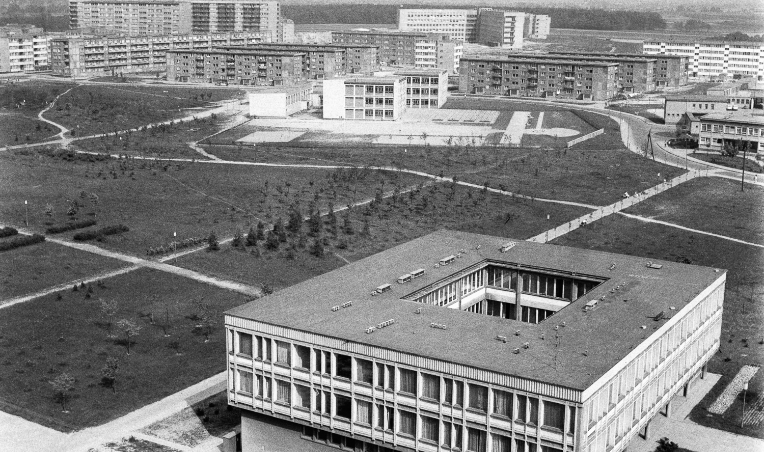 Photo by Zygmunt Wieczorek
Photo by Zygmunt Wieczorek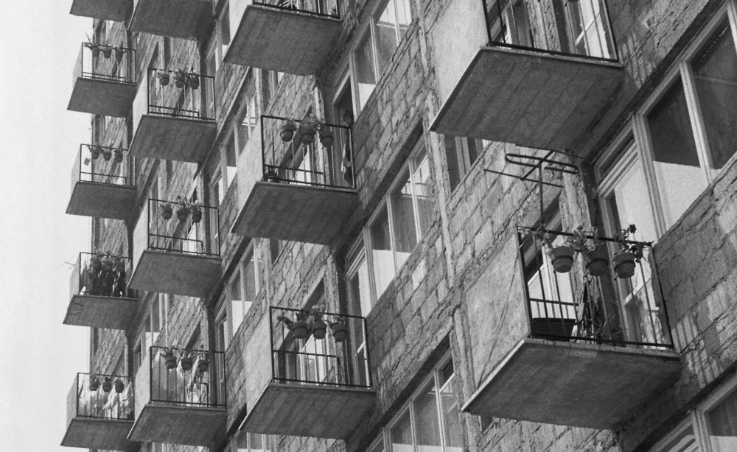 Photo by Zygmunt Kubski
Photo by Zygmunt KubskiThe original collections of Tychy photographs held by the Tychy City Museum undoubtedly focus on these vertical images, while underrepresenting the horizontal axis, i.e. the street- or eye-level zone, nowhere near as orderly and flawless as the panorama view, but closer to that everyday experience which found its manifestation in the figure of the flâneur. The rare occurrence of street level images also translates into the infrequent presentation of individual human figures: many photographs either lack them at all or they are reduced to a group, a community or a social type. In this sense, the Tychy photographs seem stuck at an early stage of modernist urban photography. There are no traces of Weeggee’s naked city, no Brassaï tries to sneakily take his mysterious night snaps, no private New York topography is charted by Diane Arbus, and no-one takes candid shots like those by Walker Evans, who keenly peeped at subway commuters.
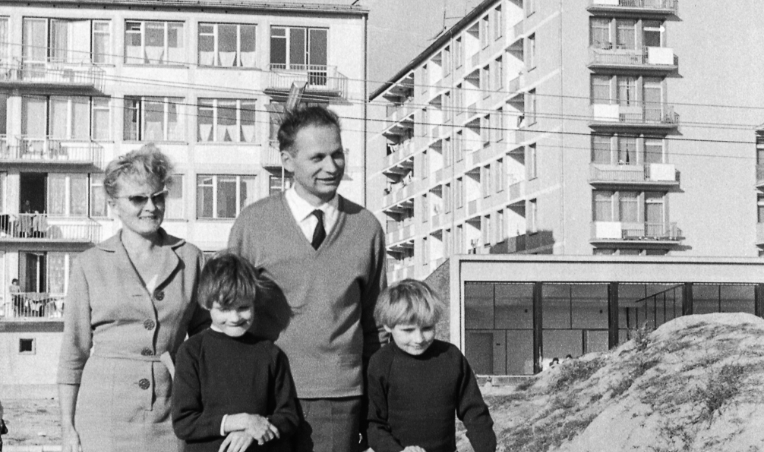 Photo by Zygmunt Kubski
Photo by Zygmunt Kubski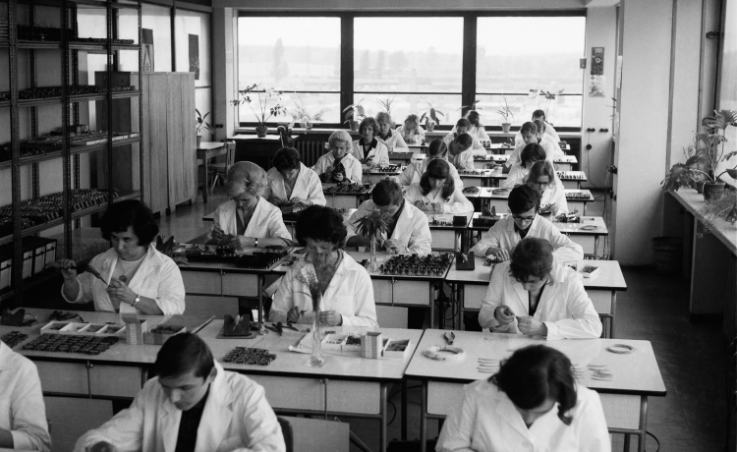 Photo by Zygmunt Wieczorek
Photo by Zygmunt WieczorekAlthough the close and privileged relations between photography and the city are indisputable, the nature of this relationship has never been clearly defined, especially if photographers' efforts are to be considered an art form, which – as we all know from the history of photography – would not be a compliment to all those indulging in photography. While some approach the city as a social work of art, it is much more common to treat it as an object of interest for artistic culture (literature, film, visual arts, photography), which produces its own imagery that often has the power to define social awareness and perception of urban space, often with a critical view of the prevailing political or economic visions of its functioning. There is yet another proposition, namely to assume that photography has a role in documenting the city, although not as a simple imitation or mirror reflection, but as a more complex, culturally underpinned representation. This refers to photographic philosophies emerging from the straight photography (or pure photography) tradition, focused on a new perception and ‘new objectivity’, and as such liberated from the aesthetic influences of visual arts. Pure photography – sharp, veristic and unprejudiced – opted for the appreciation of its own language of photography, a language which, according to its advocates, was capable of describing modernity (and within it a modern city). The emphasis on these qualities was at the heart of modernist photographic aesthetics which, having rejected pictorialism and other forms of imitative painterly approach, dominated until the 1970s and gave birth to a number of great modernist projects, such as the celebrated city ‘monographs’ of Paris (Eugène Atget), Berlin (Heinrich Zilly) or Vilnius (Jan Bułhak).
Photographic representations are intrinsically paradoxical, since – although far from mimetic realism (which was believed in the early days of photography, fuelled by assumption that mechanical reproduction is a guarantee of objectivity) – they seem to possess the power to authenticate and magically transfer us in time and space. The truth of photography is not the truth of the correspondence between reality and its image, but the truth of the constantly redefined meaning, the truth of the cognising individual that can be different every time.
Jon Wagner, an American visual sociologist, reflects on the realism of photography by invoking a British project in which six photographers were asked to take pictures of six cities, each of which was photographed by two artists. The exhibition of the work done, showed the inherently subjective nature of photography with all its sharpness: the very same city portrayed by different photographers appeared completely different in their respective photos, while different cities photographed by the same author looked very similar, especially in the eyes of people who had no first-hand experience the cities themselves. Of course, a closer look at the at the same images by people who were familiar with the cities in question, made it possible to identify their specific features, and thus break the individual perspective to reveal the intersubjective value of photography.
The photographs from the Tychy City Museum's collection are particularly striking in the context of the subjective-objective nature of photography, because despite the assumed different perceptions of photographers, resulting from the influence of historical time, or their different roles, objectives and experiences, we never seem to forget that we remain in the same city! The visual weight of the city, what draws our eye, regardless of whether we view Tychy in statu nascendi or as if it were already completed (though not quite so, which will be discussed in a moment), makes all the photographers succumb to its gravitational power, which cannot be disturbed by any artistic and professional extravagances and transgressions. Perhaps the only example of a different kind of perception are the photographs by Michał Cała, whose phantasmagoric-postapocalyptic vision of Tychy distinguishes him from the other authors, even though it is delicate scratching rather than breaking the structure, a kind of personal criticism of the neglected and devastated substance of Upper Silesia.
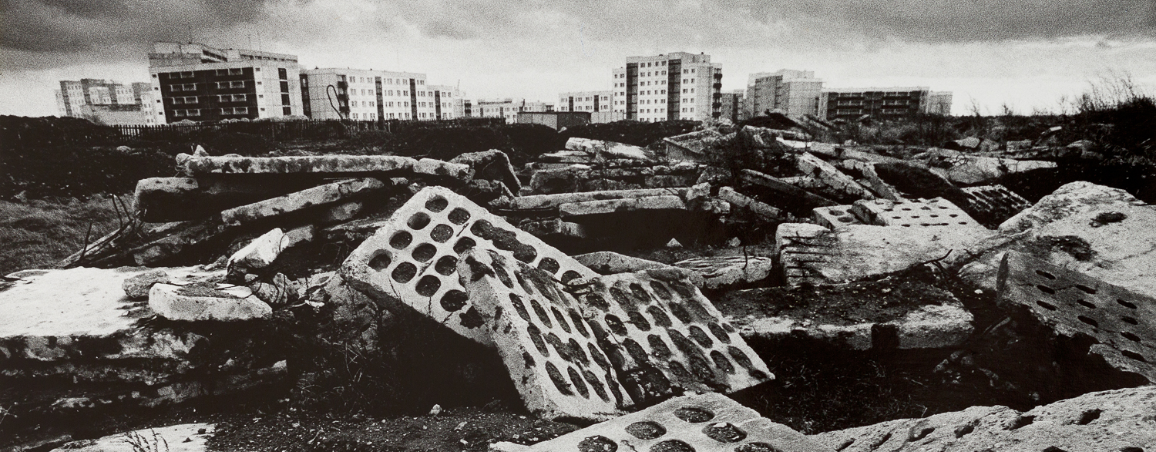 Photo by Michał Cała
Photo by Michał CałaThe Tychy photographs illustrate the transformation of the local urban landscape in time: the 1950s and early-1960s photos, which mainly depict a giant building site, are easily distinguishable from the 1970s and 1980s cycles, where construction work has already been completed and where people are busy living in the city, rather than building it. However, the completion of works does not necessarily mean the completion of the project, as evidenced by some infrastructural elements of the landscape, e.g. frail greenery, baldish garden squares, unpaved yards, provisional access roads and potholed streets, which remain basically unchanged, being the same sorry sight in Tychy (and other communist cities) both in the 1950s and in the 1980s.
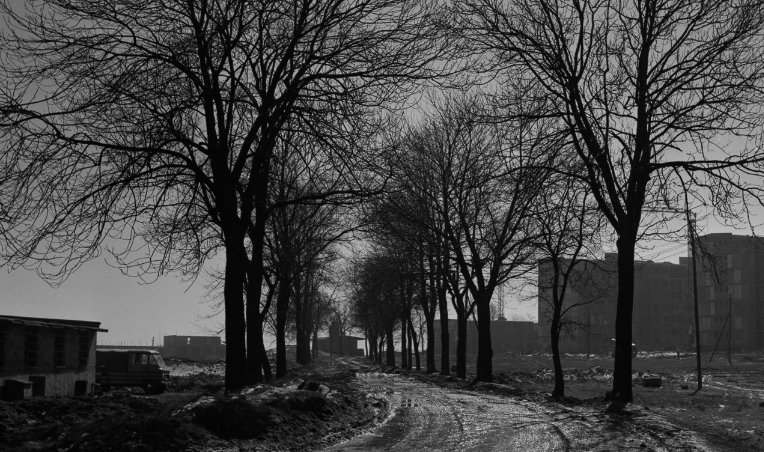 Photo by Andrzej Czyżewski
Photo by Andrzej Czyżewski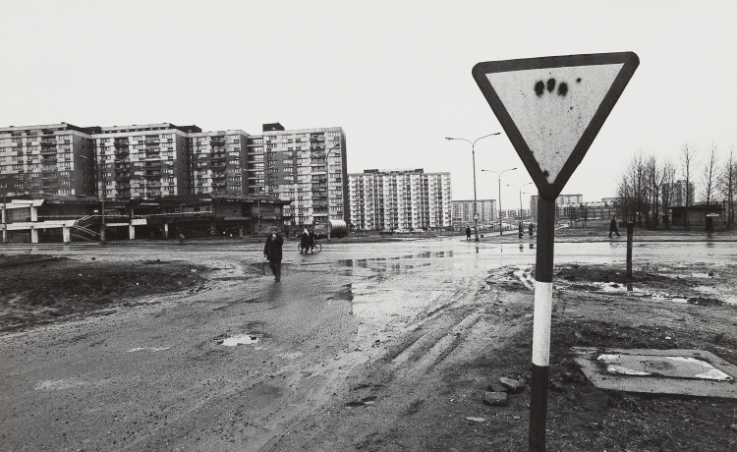 Photo by Michał Cała
Photo by Michał CałaNearly all photographers seem to notice the urban-meets-rural character of the new housing estates and eagerly emphasise this impression of the blocks being located in open fields or even 'growing' directly from grain fields. The conceptual contrast between grazing cows and concrete residential blocks proves an irresistible temptation...
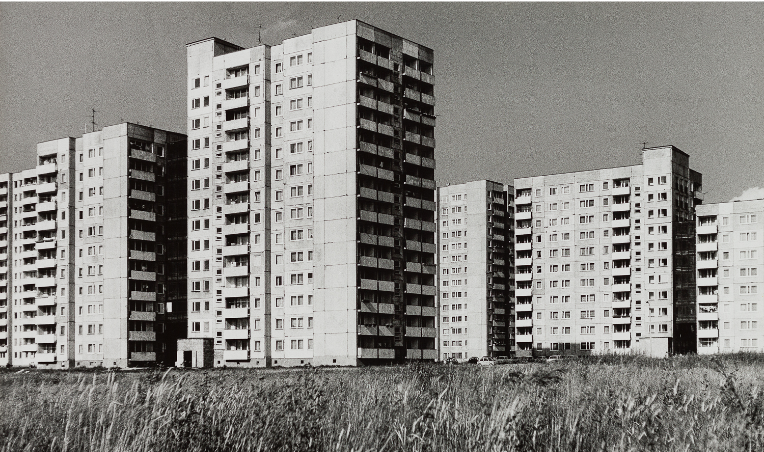 Photo by Michał Cała
Photo by Michał Cała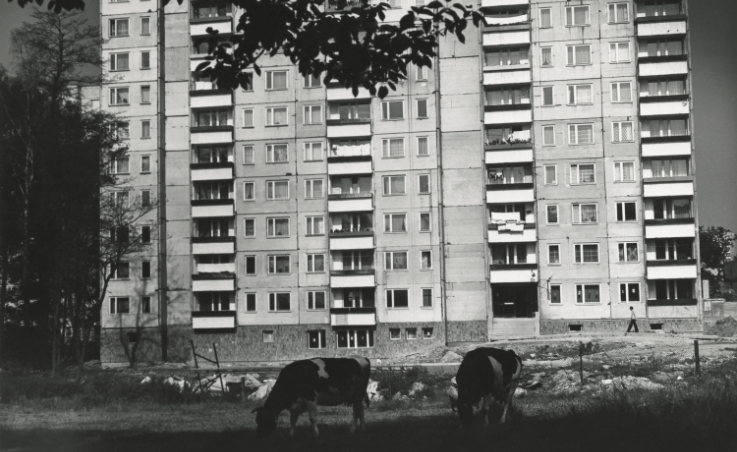 Photo by Zygmunt Kubski
Photo by Zygmunt KubskiThat ‘permanent impermanence’ is also clearly visible in relation to children's playgrounds, which seem an important marker of the level of social development. This brings to mind the words of art historian Lars Bang Larsen, who describes a neglected playground as one of the saddest sights, representing in a nutshell ‘a common inability to exercise civic freedoms, their total abandonment, or a missed opportunity to improve social sensitivity’., and all of that because ‘the very idea of creating a playground for children as a way of focusing dispersed folk energy teaches us contemporary attitudes: how to rise after one trips and falls and how to learn to use one's own mind without outside help". There are either no playgrounds in Tychy's housing estates at all, or these facilities are reduced to single devices that look like creepy props in a post-nuclear computer game. But beware: children represent untamed energy; they are pioneers who conquer new territories and adapt them to their needs. They can create playgrounds from nothing wherever they are. A heap of sand left by the builders in the winter season is a good-enough slide, construction equipment must be explored from all sides, carpet hangers and rubbish bins will serve as gymnastic equipment, while a large mud puddle is a perfect setting for the next adventure of the young conquerors of the Amazon!
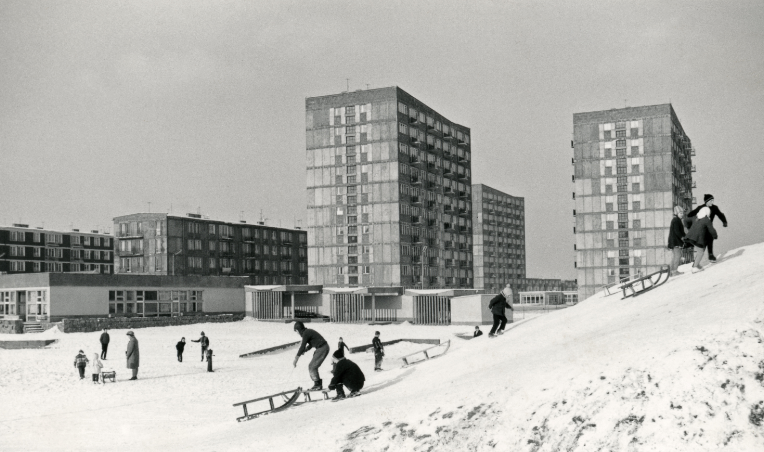 Photo by Zygmunt Kubski
Photo by Zygmunt Kubski Photo by Andrzej Czyżewski
Photo by Andrzej Czyżewski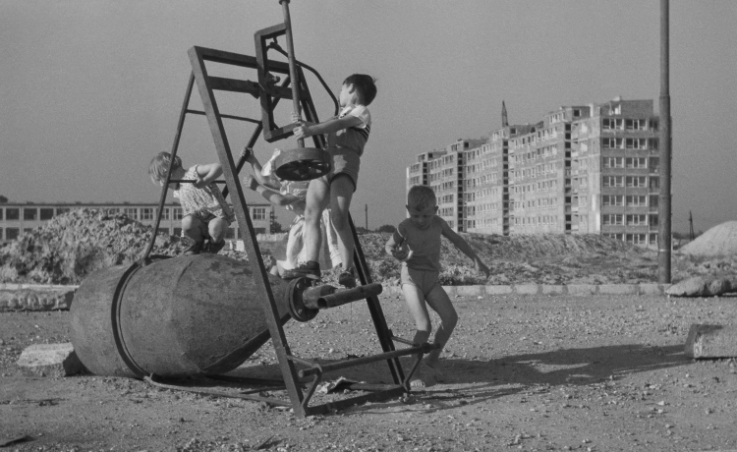 Photo by Andrzej Czyżewski
Photo by Andrzej Czyżewski Photo by Andrzej Czyżewski
Photo by Andrzej CzyżewskiA photograph is a casual paraphrase or perhaps an interpretation of reality, rather than a direct quote from it, because a photographer's camera registers images to the same degree as it creates them. It is a tool other than the standard methods of cognition and reporting used in science. The merits of photography do not derive from the fact that it is a faithful copy of the reality, but from the fact that it portrays it in a new light, in a different, more intense manner, drawing our attention to what is usually overlooked. Only in this sense can photography be considered a reliable source of knowledge or data.
Graham Clarke zauważa, że w XIX w. miasto stało się dla aparatu najważniejszym obrazem; podwaliny fotografii miasta ufundowało zwłaszcza XVIII-wieczne zainteresowanie panoramą, przejęte przez fotografię: „wyniesienie aparatu ponad miasto ustanowiło jedną z pierwotnych osi, wedle których fotograf orientował swoje poszukiwania odpowiedniej formy przedstawienia miejskiego krajobrazu. I czy była to w pełni rozwinięta panorama, miejsce widokowe czy spojrzenie z okna na górze, fotograf zawsze próbował wznieść się powyżej poziomu ulicy, a kiedy mu się to nie udawało, spoglądał z ulicy w górę, ku niebu, na najwyższe punkty miasta”01.
01 Graham Clarke. 2010. Miasto w fotografii. W: Ewa Rewers (red.) Miasto w sztuce – sztuka miasta. Kraków: Universitas, s. 457. Photo by Zygmunt Wieczorek
Photo by Zygmunt Wieczorek Photo by Zygmunt Kubski
Photo by Zygmunt KubskiAutorskie kolekcje fotografii Tychów ze zbiorów Muzeum Miejskiego w Tychach niewątpliwie skupiają się na tych wertykalnych obrazach, ale słabiej reprezentowana jest oś horyzontalna, poziom ulicy, przestrzeń na wysokości wzroku, nie tak uporządkowana i nieskalana jak przestrzeń typowa dla doświadczenia panoramy, ale bliższa codziennemu doświadczeniu, które swoją kumulację odnalazło w postaci „flâneura”. Rzadka obecność poziomu ulicy na tyskich fotografiach wyraża się też w nieczęstym pokazywaniu indywidualnych ludzkich postaci: na wielu zdjęciach albo w ogóle ich nie ma, albo zredukowane są do kolektywu, zbiorowości czy typów społecznych. W pewnym sensie fotografia Tychów zatrzymała się na wczesnym etapie modernistycznej fotografii miasta. Brak w tyskich fotogramach nagiego miasta Weeggee’ego, żaden Brassaï nie próbuje skraść jego sekretnych nocnych wizerunków, nie ma prywatnej topografii rodem z Nowego Jorku Diane Arbus, nikt nie fotografuje z ukrycia jak Walker Evans, podglądający podróżujących metrem.
 Photo by Zygmunt Kubski
Photo by Zygmunt Kubski Photo by Zygmunt Wieczorek
Photo by Zygmunt WieczorekBliskie i uprzywilejowane związki fotografii z miastem nie budzą wątpliwości, jednak natura tej relacji nigdy nie była jednoznacznie zdefiniowana, zwłaszcza jeśli poczynania fotografów uznać za formę sztuki, co – jak dobrze wiemy z historii fotografii – nie dla wszystkich fotografujących byłoby komplementem. W niektórych ujęciach miasto można potraktować jako społeczne dzieło sztuki, jednak znacznie częstsze jest traktowanie go jako przedmiotu zainteresowania kultury artystycznej (literatury, filmu, sztuk plastycznych, fotografii), która buduje swoje własne obrazy, nierzadko mające moc definiowania społecznej świadomości i sposobu postrzegania miejskiej przestrzeni, czasami krytyczne wobec dominujących, determinowanych politycznie czy ekonomicznie, wizji funkcjonowania miasta. Jeszcze inną możliwością jest przyjęcie, że fotografia pełni wobec miasta funkcję dokumentującą, choć nie jest to proste naśladowanie czy lustrzane odbicie, lecz bardziej złożona, kulturowo podbudowana reprezentacja. Mowa tutaj o fotografii wyrastającej z tradycji straight photography, nowej albo czystej fotografii, nakierowanej na nowe widzenie i „nową rzeczowość”, wyemancypowanej spod wpływów estetyki sztuk plastycznych. Czysta fotografia – ostra, werystyczna i nieuprzedzona – stawiała na dowartościowanie własnego języka fotografii, języka, który według jej zwolenników potrafi opisywać nowoczesność (a w jej ramach nowoczesne miasto). Nacisk na te cechy zdominował estetykę fotografii modernistycznej, która po odrzuceniu piktorializmu i innych form naśladowania malarstwa, dominowała aż do lat 70. XX w. i zrodziła wielkie modernistyczne projekty, takie jak słynne „monografie” miast, np. Paryża (Eugène’a Atgeta), Berlina (Heinricha Zillego) czy Wilna (Jana Bułhaka).
Reprezentacje fotograficzne są w swojej istocie paradoksalne, bo – choć dalekie od mimetycznego realizmu (w który wierzono w początkach przygody z fotografią, zakładając, że mechaniczna reprodukcja jest gwarantem obiektywizmu) – to posiadają siłę poświadczania i magicznego przenoszenia nas w czasie i przestrzeni. Prawda fotografii nie jest prawdą zgodności między rzeczywistością a jej obrazem, lecz prawdą bezustannie redefiniowanego znaczenia, prawdą poznającego podmiotu, który za każdym razem może być inny.
Jon Wagner, amerykański socjolog wizualny, rozważając kwestię realizmu fotografii, przywołuje brytyjski projekt, w którym sześciu fotografów poproszono o wykonanie zdjęć sześciu miast, przy czym każde z nich było fotografowane przez dwójkę artystów. Wystawa przygotowana na podstawie wykonanych prac z całą ostrością pokazała subiektywną naturę fotografii: to samo miasto fotografowane przez różnych fotografów wyglądało na zdjęciach zupełnie inaczej, za to różne miasta fotografowane przez tego samego autora wyglądały na bardzo do siebie podobne, zwłaszcza w oczach osób nieznających wybranych miast. Rzecz jasna dokładniejsze przyjrzenie się uwiecznionym na fotografiach miastom przez ludzi dobrze z nimi zaznajomionych, pozwalało – poprzez wyodrębnienie cech szczególnych – na ich prawidłową identyfikację, przełamując indywidualne spojrzenie i odsłaniając intersubiektywną wartość fotografii02.
02 Jon Wagner. 1979. Avoiding Error. W: tenże (red.) Images of Information: Still Photography in the Social Sciences. Beverly Hills/London: SAGE Publications, s. 147.Fotografie ze zbiorów Muzeum Miejskiego w Tychach w kontekście subiektywno-obiektywnej natury fotografii zaskakują, bo oglądając je, pomimo zakładanych różnic w sposobach widzenia, już to wynikających z wpływu czasu historycznego, już to z odmiennych ról, celów i doświadczeń fotografujących, ani na moment nie zapominamy, że pozostajemy w jednym i tym samym mieście! Wizualny ciężar tego miasta, to, co przyciąga nasz wzrok, niezależnie od tego, czy patrzymy na Tychy „in statu nascendi”, czy na miasto niby-to-już-gotowe (choć nie do końca, o czym za chwilę) sprawia, że wszyscy autorzy poddają się jego sile grawitacyjnej, której artystyczno-zawodowe ekstrawagancje i transgresje nie są w stanie zakłócić. Jedynym chyba przykładem odmiennej trajektorii widzenia są zdjęcia Michała Cały, który w swoim fantasmagoryczno-postapokaliptycznym widzeniu Tychów odróżnia się od pozostałych autorów, acz jest to raczej delikatne zarysowanie struktury, a nie jej przełamanie, rodzaj autorskiej krytyki zaniedbanej i zdewastowanej substancji Górnego Śląska.
 Photo by Michał Cała
Photo by Michał CałaFotografie Tychów pokazują, jak lokalny krajobraz miasta przekształca się w czasie: zdjęcia z lat 50. i wczesnych 60., na których królują obrazy wielkiego placu budowy, łatwo odróżnić od serii z lat 70. i 80., na których działania konstrukcyjne zostały już ukończone, a ludzie zajmują się życiem w mieście, a nie jego budową. Jednak zakończenie prac nie musi oznaczać ukończenia dzieła, bo pewne infrastrukturalne elementy tego krajobrazu pozostają w zasadzie niezmienne: rachityczna zieleń, łysawe skwery i place, prowizorycznie wykończone dojazdy i ulice straszyły w Tychach (i innych PRL-owskich miastach) tak samo w latach 50./60. i w latach 80.
 Photo by Andrzej Czyżewski
Photo by Andrzej Czyżewski Photo by Michał Cała
Photo by Michał CałaPrawie wszyscy fotograficy zdają się dostrzegać miejsko-wiejski charakter nowych tyskich osiedli i ochoczo podkreślają to wrażenie ulokowania bloków w szczerym polu czy wręcz ich „wyrastania” wprost z łanów zboża. Konceptualny kontrast krów wypasanych między blokami stanowi pokusę nie do odparcia…
 Photo by Michał Cała
Photo by Michał Cała Photo by Zygmunt Kubski
Photo by Zygmunt KubskiPonadczasową tymczasowość dobrze też widać w stosunku do placów zabaw dla dzieci, które można potraktować jako ważny wskaźnik poziomu rozwoju społecznego. Przypominają się słowa historyka sztuki Larsa Banga Larsena, zaniedbany plac zabaw nazywające jednym z najsmutniejszych widoków, który jak w miniaturze „przedstawia powszechną nieumiejętność korzystania z wolności obywatelskiej, jej całkowite zaniechanie lub niewykorzystaną szansę na poprawę wrażliwości społecznej”03, a wszystko to dlatego, że „Już sama idea stworzenia placu zabaw dla dzieci, jako pozwalającego na ukierunkowanie rozproszonej energii ludycznej, uczy nas współczesnych postaw: aby podnieść się po potknięciu i upadku albo jak nauczyć się wykorzystywać własny rozum bez pomocy z zewnątrz”04. Na tyskich osiedlach placów zabaw albo w ogóle nie ma, albo są to pojedyncze urządzenia, które wyglądają jak rekwizyty budujące nastrój grozy w postnuklearnej grze komputerowej. Ale uwaga: dzieci to nieujarzmiona energia, pionierzy zdobywający nowe terytoria i przystosowujący je do swoich potrzeb. Tworzą place zabaw bez niczyjej pomocy, z niczego, gdziekolwiek bądź. Pozostawiona przez budowlańców hałda piachu zimową porą służy za zjeżdżalnię, maszyny budowlane można z każdej strony eksplorować, trzepak i śmietniki da się wykorzystać jako sprzęt gimnastyczny, a błotna niecka pozwala odkryć w sobie ducha zdobywców Amazonii!
03 Lars Bang Larsen. 2014. Kręgi na wodzie. Gra w tonacji dur. W: Bogna Świątkowska (red.) My i oni. Przestrzenie wspólne i projektowanie dla wspólnoty. Warszawa: Fundacja Bęc Zmiana, s. 221. 04 Tamże. Photo by Zygmunt Kubski
Photo by Zygmunt Kubski Photo by Andrzej Czyżewski
Photo by Andrzej Czyżewski Photo by Andrzej Czyżewski
Photo by Andrzej Czyżewski Photo by Andrzej Czyżewski
Photo by Andrzej CzyżewskiFotografia to raczej swobodna parafraza czy nawet interpretacja, a nie cytat z rzeczywistość, bo aparat fotograficzny w równym stopniu rejestruje dane, co je tworzy. Jest narzędziem innym niż standardowo wykorzystywane w nauce metody poznawania i raportowania. Wartość fotografii nie wynika z faktu, że jest wierną kopią rzeczywistości, lecz z tego, że pokazuje ją w nowym świetle, inaczej, intensywniej i zwraca naszą uwagę na to, co zazwyczaj jest pomijane. Tylko w takim sensie fotografia może być potraktowana jako wiarygodne źródło poznania czy baza danych.